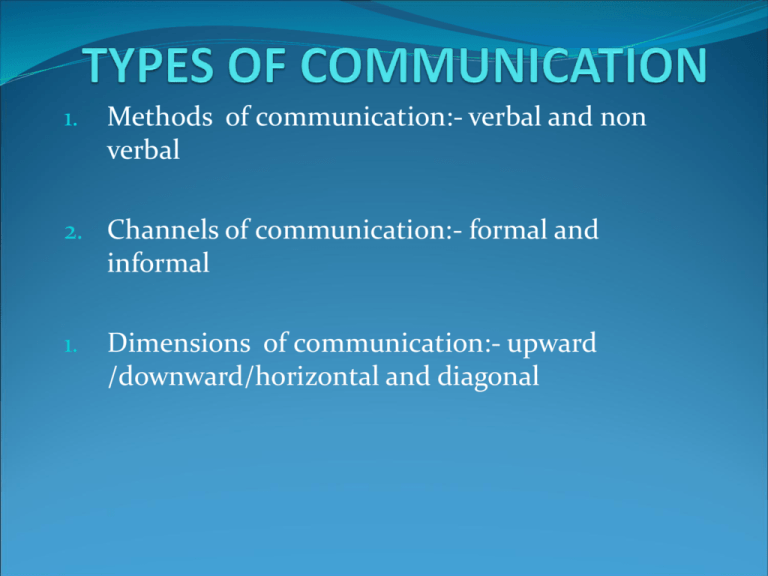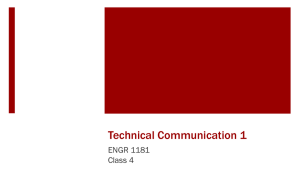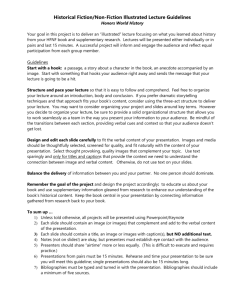TYPES OF COMMUNICATION
advertisement

1. Methods of communication:- verbal and non verbal 2. Channels of communication:- formal and informal 1. Dimensions of communication:- upward /downward/horizontal and diagonal Types of communication When John entered in his office on Monday morning:- -somebody had tempered with his personal computer -called up his personal secretary and enquired - Secretary informed that two marketing executives had come on the Saturday evening -used the computer to seek some information since he was not there -John called the two marketing executives and told them not to touch his computer without his permission Types of communication -John although practically did not scold them but -tone was very stern -to avoid this in future he issued a memo to this effect -distributed it in the office -Next day everybody in his office was discussing about the episode -almost everybody was aware that they are not supposed to use boss’s computer without his permission Types of communication Here John used –Speech(words spoken) Writing(memo) Body language -(his expressions when he talked to the marketing executives) Paralanguage-(stern tone of his voice)to make people aware of his sentiments Both formal -(memo) and informal channels -(discussion among the employees contributed to spread the news Types of communication Note the dimensions of communication even in a small office environment John-enquires from his secretary/scolds the marketing executives/issues the memo -all are downward communication Secretary reports and & marketing executives reply to John -Upward communication Secretary enquires about who came in the boss’s room -Horizontal communication Methods of communication One of the ways of communicating is by using words- by way of speech/by writing Another is by using the expression other than words -gestures/body language etc A third mode of communication is –circumstantial communication -here people communicating make no deliberate effort the message is conveyed by the way the things are Example-the elaborate décor of one’s office room conveys that he is holding a high position in the organization Methods of communication Lets divide our discussion into two categories Verbal communication Non –verbal communication Verbal communication-The term “verbal” denotes the use of words When words are used in communication – spoken/written we call it verbal communication The thoughts in words can be conveyed either orally or by writing Oral Communication Oral communication is the communication by way of uttering words Speaking –which is the fastest /most direct type of communication -Every time we speak our voice reveals Gender/age/geographic background/level of education/native birth/emotional state/relationship with the person spoken to All these clues (and many more) are contained in even small fragments of speech People can read our voices -When we speak-encode important info about ourselves When we listen-we decode- Oral communication In an Organization: Formal staff meetings/planned conferences/mass meeting Informal talks-suitable for day to day liaison/directions/exchange of information/progress review -maintenance of effective interpersonal relations Telephone calls are used for quick checkups and for imparting or receiving information Channels for oral communication:-face to face conversation/telephone/presentation/public speech/interview/group discussion/negotiation/meeting Advantages of oral communication Speed-once you make contact with your audience there is no time lag between the transmission and reception of message/this is valuable when time is essence-ie funds in an account to be released/memos will not be of much help Speaker is able to get personal attention of the listener/spend hrs drafting a letter-recipient scans superficially or will not read/much command over receivers attention It allows instantaneous feedback:-you can respond/rephrase/revise to your audience Advantages Personal quality:- when a personal meeting goes well the relationship that communicators develop can help solve problems that might have been difficult while handling from distance-personal meetings important in some cultures Confidentiality:- since creates no records/helps in maintaining confidentiality Supplemented by non –verbal clues:- The person receiving oral communication can combine it with expressions/other non verbal clues around the speaker-message better understood Limitations of oral communication Oral might not be the best approach it suffers from certain disadvantages: No evidence:-No documentary proof of oral communication/impact is temporary Not suitable in certain cases:-when message is too lengthy and complex Expensive & time consuming when the persons involved are at distant locations-difficulty in arranging the communicators/Even a cross town trip for a half – hour meeting can take most of the morning/afternoon Limitations of oral communication Not appropriate when the matter is controversial:-A personal contact might also be unproductive if the contact antagonizes one or more participants/if personalities or subject-make someone angry/defensive/less confrontational forms of communication to be used Serious deliberation is not possible:-receiver has to take an immediate decision in response to the communication received More prone to physical noise:-Oral message has more probability of getting distorted –physical noise/inaudibility of speech/interference Written communication Written communications are a powerful medium in all walks of life We may handle our social & business communication on a face to face basis we need to prepare written messages the reason: Permanent record/matter may be complex/sensitive which needs planning before communicating/distance There are many types of written business communication/fax/letters/memorandums/notices/ -forms /reports/circulars Each document is used in different purposes in different circumstances in business Written communication Written communication have a different set of advantages than their spoken counterparts Written communication is permanent:-saved as future reference Written communication can be easier to understand than speech It can be composed in advance Written messages are less prone to errors Written communication works best as evidence It can address more number of persons at a timeadvertisement in news paper/hoardings - TV can also cover a large population by oral communication/but written media is cheap and coverage is more Limitation Time consuming-in terms of preparing & understanding Lot of paperwork-creates mountains of papers cluttered around/difficult to manage/careful with confidential matters Certain messages cannot be put into writing-better understood orally/nonverbal Different persons may interpret message differently-if not carefully worded /written communication may give rise of legal battles Limitation Immediate feedback and clarification is not possible in written communication Needs expertise in expression-runs the risk of being ineffective in the hands of people otherwise good in their job/serious concern for organization Lack of confidentiality-when they pass through several hands Capability to cause greater damage-A haphazardly written note can do more damage than a careless remark Contd After going through the written and oral communication we should understand that solely one mode may not be useful The two modes are supplementary and should be used depending upon the situation Written communication is more useful –subject matter is complex & final decision requires deliberations from the persons concerned/messages need to be preserved for future reference or have legal implications Oral communication can be relied upon in routine & day to day matters/confidential matter Exercise Rewrite these Sentences so that they are clearer & more concise To make certain that the materials you remove from the Office supply room are fully accounted for in our inventory system, I am requesting that you completely and accurately fill out the standard form provided for the purpose. Fill out a form whenever you take office supplies so that our inventory will be correct. Contd In the absence of the feline race, certain small rodents will give themselves up to various pleasurable pastimes. When the cat’s away, the mice will play A plethora of culinary specialists vitiate the liquid in which a variety of nutritional substances have been simmered. Too many cooks spoil the broth Impetuous celerity engenders purposeless spoilage. Haste makes waste.






